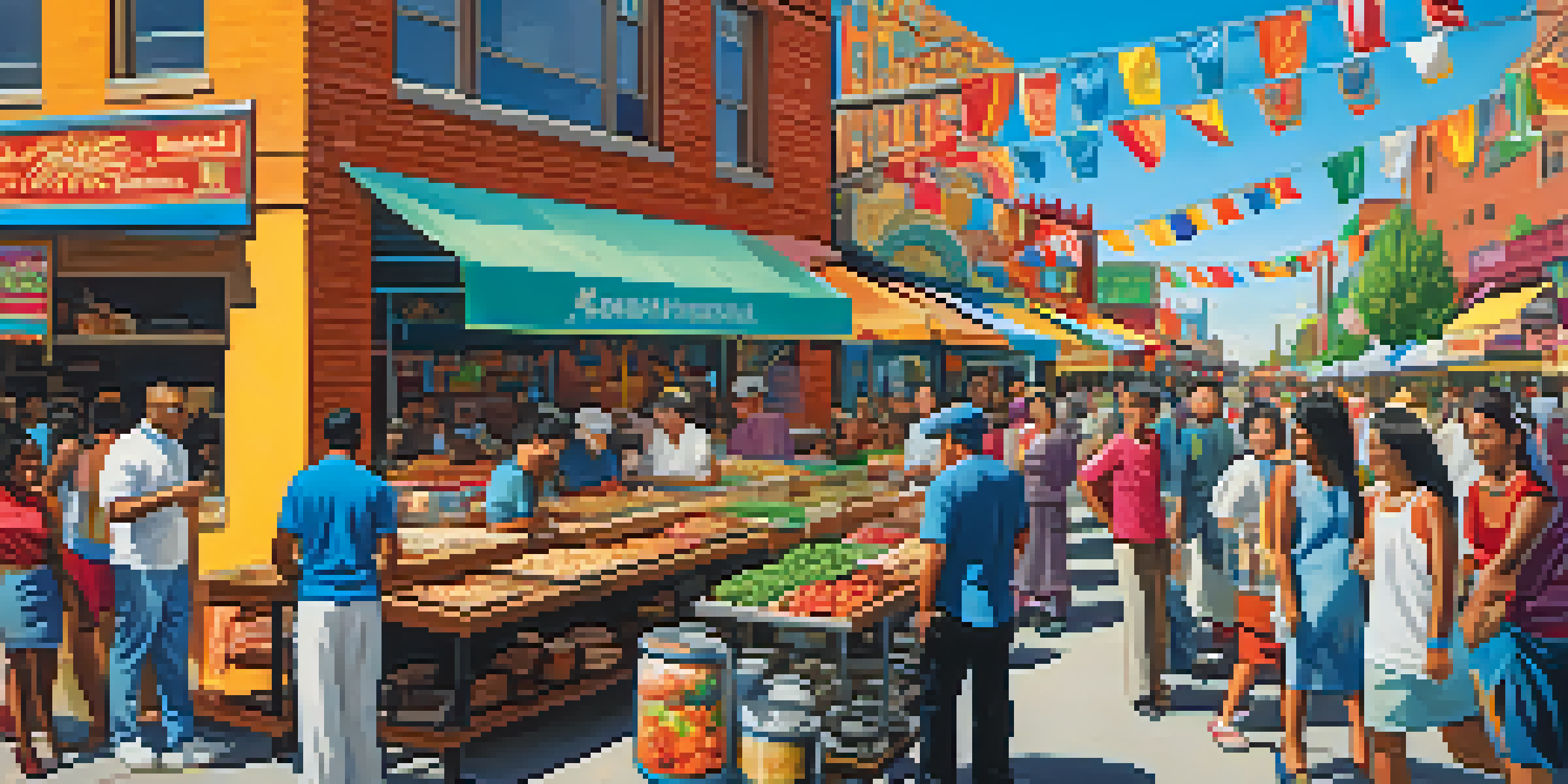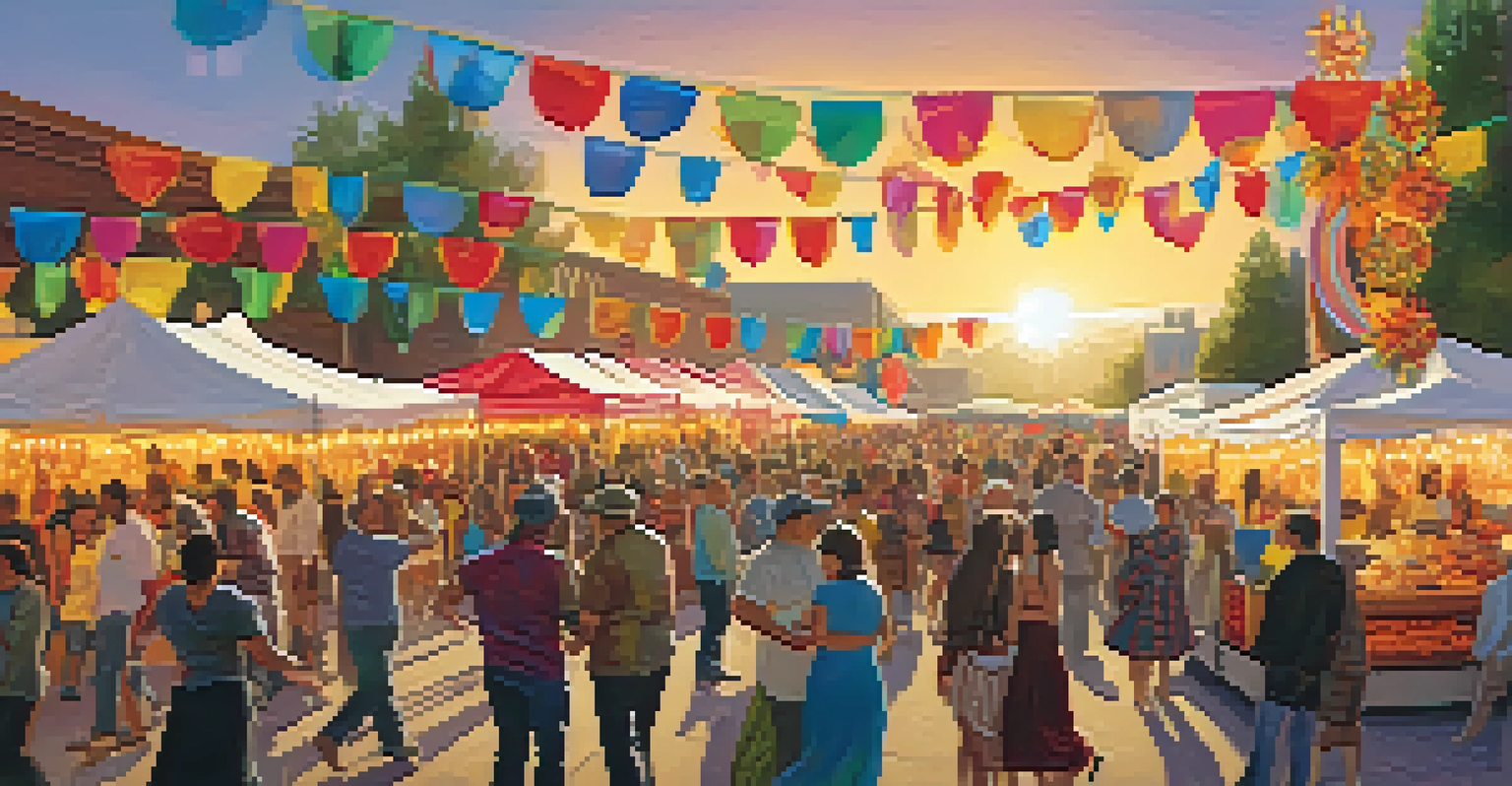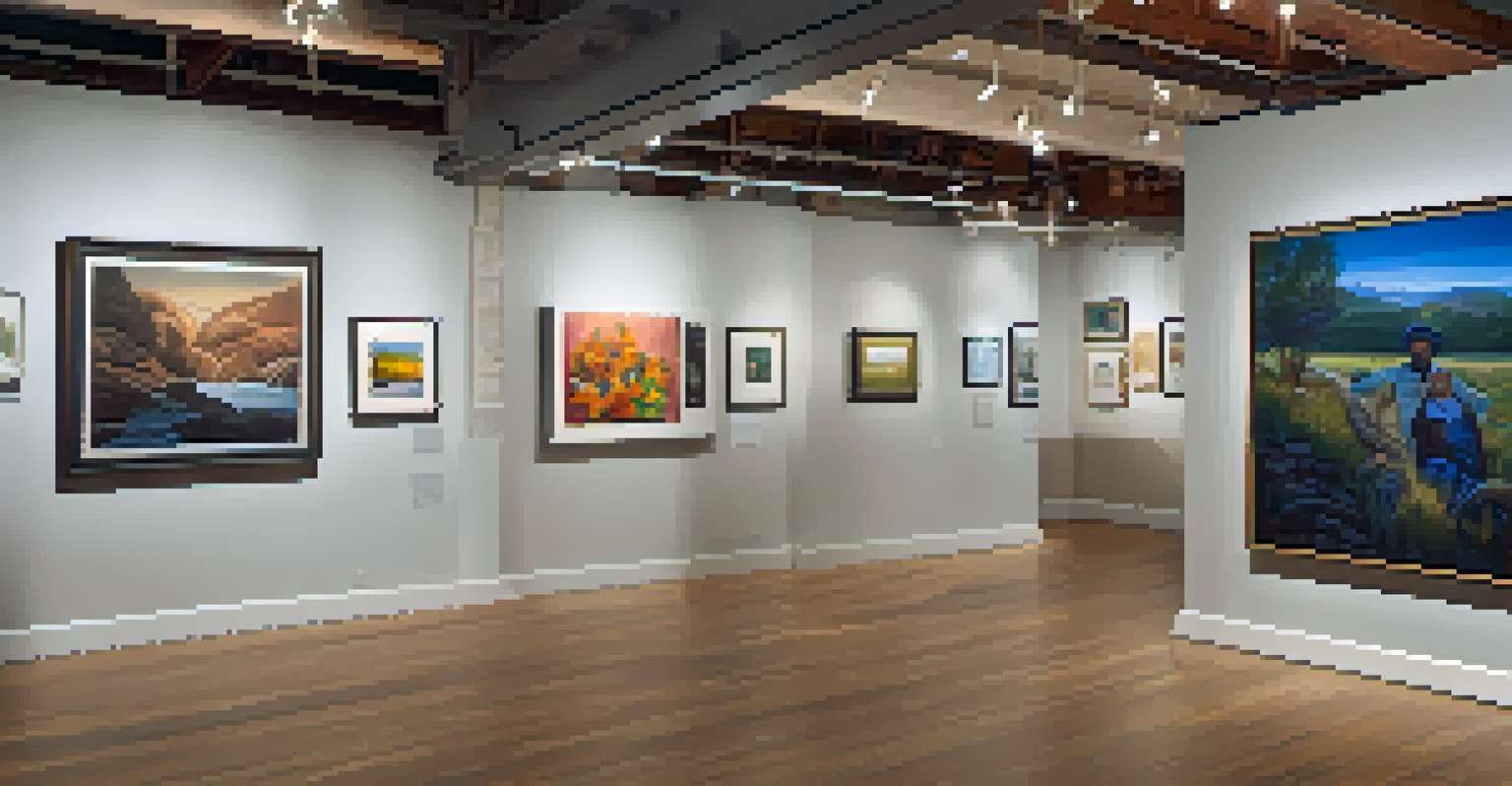The Role of Immigrant Communities in Denver's Culture Scene

A Melting Pot: The Diversity of Denver's Immigrant Communities
Denver is often described as a melting pot, where diverse cultures blend together to create a unique atmosphere. Immigrant communities from Latin America, Asia, Europe, and beyond have settled in the city, each contributing their own flavors, traditions, and values. This rich tapestry not only enhances daily life but also shapes Denver's identity as a cultural hub.
Diversity is the one true thing we all have in common. Celebrate it every day.
For instance, you can stroll through neighborhoods like Aurora, where vibrant murals and international eateries reflect the stories of various immigrant groups. These communities bring their languages, festivals, and culinary delights, inviting locals and visitors alike to experience something new. As a result, Denver thrives as a city that celebrates its multicultural roots.
Moreover, this diversity fosters a sense of belonging among residents, creating connections across cultural lines. It encourages dialogue, understanding, and collaboration, making Denver a place where everyone can find a slice of home, no matter where they come from.
Cultural Festivals: A Celebration of Heritage and Unity
One of the most visible expressions of immigrant contributions to Denver's culture is through its vibrant festivals. Events like the Denver Day of Rock, the National Western Stock Show, and the annual Cinco de Mayo celebration highlight the rich traditions of various communities. These festivals not only showcase unique cultural practices but also promote unity among different ethnic groups.

At these events, you can enjoy traditional music, dance, and food, immersing yourself in a world of colorful experiences. For example, the Dragon Boat Festival celebrates Asian heritage with races, cultural presentations, and delicious Asian cuisine. Such gatherings create opportunities for cultural exchange and strengthen community bonds.
Denver's Cultural Diversity Shines
The city's immigrant communities enrich Denver's cultural landscape with unique traditions, cuisines, and art forms.
Through these festivals, Denver residents gain a deeper appreciation for the diverse heritages present in their city. They encourage participation and inclusivity, allowing everyone to join in the celebrations, regardless of background, fostering a spirit of solidarity and understanding.
Art and Expression: Immigrants as Cultural Innovators
Immigrant communities in Denver have made significant contributions to the city’s art scene, influencing various forms of creative expression. From visual arts to music and dance, these communities bring unique perspectives and styles that enrich the local culture. Artists like Carlos Frésquez, who blends Chicano influences with contemporary themes, exemplify the innovative spirit found within these communities.
The beauty of the world lies in the diversity of its people.
Art installations and performances often reflect the personal experiences of immigrants, telling stories of struggle, resilience, and hope. For instance, community art projects in neighborhoods like Globeville often address social issues while celebrating cultural identity, providing a platform for voices that may otherwise go unheard. This dynamic interplay between culture and art fosters a rich dialogue about identity and belonging.
Additionally, galleries and performance spaces dedicated to immigrant artists help cultivate a thriving creative ecosystem. By showcasing diverse artistic expressions, Denver continues to evolve as a city that appreciates and supports the contributions of its immigrant populations.
Culinary Contributions: A Taste of the World in Denver
Denver's culinary scene is a delicious testament to the influence of its immigrant communities. Restaurants and food trucks serving traditional dishes from around the globe have become staples of the city’s dining landscape. Whether it's savoring authentic Mexican tacos or indulging in Ethiopian injera, Denver offers a culinary adventure for food lovers.
Each immigrant group brings its own culinary traditions, techniques, and flavors, creating a diverse food culture. For example, the rise of Korean BBQ restaurants and Vietnamese pho shops has introduced Denverites to new tastes and dining experiences. These eateries not only satisfy hunger but also serve as cultural ambassadors, helping to educate diners about different cuisines.
Festivals Foster Unity and Inclusion
Cultural festivals in Denver celebrate heritage while promoting understanding and collaboration among diverse ethnic groups.
Moreover, local food festivals and markets celebrate this diversity, allowing chefs to showcase their heritage and culinary skills. Events like the Denver Food and Wine Festival highlight the city's gastronomic richness, encouraging creativity and collaboration among chefs from different backgrounds. As a result, Denver's food scene continues to evolve, reflecting the city's multicultural identity.
Music and Dance: Rhythms from Around the Globe
The music and dance scene in Denver is greatly enriched by the contributions of immigrant communities. From salsa and cumbia to traditional African drumming, these cultural forms have found a home in the city. Venues like Cervantes' Masterpiece Ballroom and the Paramount Theater often host performances that celebrate these vibrant art forms, bringing people together through rhythm and movement.
Local musicians and dancers draw from their cultural roots, creating a fusion of styles that captivates audiences. Events such as the Denver Jazz Festival and the Global Dance Festival showcase this blending of traditions, highlighting the creativity and innovation that emerge from diverse backgrounds. The energy and passion of these performances can be felt throughout the city, uniting people through the universal language of music.
As these art forms continue to evolve, they also create spaces for cultural dialogue and understanding. Workshops and community classes provide opportunities for people of all backgrounds to learn and participate, promoting inclusivity and appreciation for different traditions. In this way, Denver becomes a stage where immigrant communities share their stories and experiences through the power of music and dance.
Challenges Faced by Immigrant Communities in Denver
While immigrant communities enrich Denver’s culture, they also face significant challenges. Issues such as language barriers, discrimination, and economic disparities can hinder their ability to fully participate in the cultural scene. Many immigrants struggle to access resources and opportunities, making it difficult to share their talents and contributions with the wider community.
For instance, some artists may find it challenging to secure funding or recognition due to systemic inequalities. This can limit their ability to showcase their work, ultimately affecting the diversity of the cultural landscape. Moreover, navigating bureaucratic processes can be daunting for many immigrants, further complicating their integration into the community.
Challenges Demand Community Support
Despite facing obstacles like discrimination and language barriers, community initiatives strive to empower immigrant populations.
Despite these challenges, many community organizations and advocates work tirelessly to support immigrant populations. Initiatives aimed at providing resources, language classes, and networking opportunities can help bridge the gap, enabling immigrants to thrive. By addressing these obstacles, Denver can continue to foster a vibrant and inclusive cultural scene that reflects the contributions of all its residents.
The Future of Denver’s Cultural Scene: Embracing Diversity
Looking ahead, the future of Denver’s cultural scene hinges on the continued embrace of diversity. As more immigrants settle in the city, their contributions will further enhance the rich cultural fabric that makes Denver unique. By promoting inclusivity and encouraging collaboration among different communities, the city can ensure that its cultural scene remains dynamic and vibrant.
Community engagement and support for local artists will be crucial in fostering a thriving cultural environment. Initiatives that elevate underrepresented voices and promote cross-cultural exchanges can help create spaces for dialogue and understanding. Additionally, investing in cultural programs and festivals will allow the city to celebrate its diversity while attracting visitors and supporting local economies.

Ultimately, the strength of Denver's culture lies in its ability to adapt and evolve. By honoring the contributions of immigrant communities and fostering an inclusive atmosphere, Denver can continue to shine as a beacon of creativity and innovation, inspiring future generations to share their stories and celebrate their heritage.
Conclusion: The Heart of Denver Beats with Cultural Diversity
In conclusion, immigrant communities play a vital role in shaping Denver's cultural scene. Their contributions enrich the city, offering a multitude of experiences that reflect the beauty of diversity. From culinary delights to vibrant festivals, the impact of these communities can be felt across various aspects of life in Denver.
As we continue to navigate challenges and celebrate achievements, it's essential to recognize and support the voices of immigrants in our cultural landscape. By fostering a sense of belonging and encouraging collaboration, Denver can thrive as a city that truly embodies the spirit of community and inclusivity.
The heart of Denver beats stronger with the vibrant rhythms and colors brought by its diverse immigrant populations. Together, we can ensure that this cultural richness remains a central part of the city's identity for years to come.